I am trying to plot estimated and actual depth values on a river that I worked on. It seems as if the time period when the estimated and actual overlap, the estimated does not output correctly, even though I have estimated values up until September 2012 (the end time on the graph)
library(ggplot2)
library(scales)
LowerHydro<-data.frame(LowerHydrology)
LowerHydro$date <- as.Date(LowerHydro$Date, format = "%m/%d/%y")
LowerHydro<-rename(LowerHydro,c(Clarks.Lower..m.="Depth"))
qplot(main="Lower Clarks Hydrograph",xlab="Date",ylab="Depth(m)",
date,Depth,data=LowerHydro,group=Group,color=Group,geom="line") +
geom_line(lwd=0.70) +
scale_x_date(labels=date_format("%b-%y"),
breaks="60 days",
limits = as.Date(c("2010-10-01","2012-09-12")),
expand=c(0.01,0)) +
theme_bw()+
labs(colour="") +
scale_y_continuous(expand=c(0.03,0),
limits=c(4,20),
breaks=seq(4,20,by=2),
labels=seq(4,20,by=2)) +
theme(axis.title.x=element_text(face='bold',size=16,vjust=-2)) +
theme(axis.title.y=element_text(face='bold',size=16,angle = 90,vjust=-0.2,hjust=0.5)) +
theme(plot.title=element_text(face='bold',size=25,vjust=2)) +
theme(axis.text.x=element_text(size=12)) +
theme(axis.text.y=element_text(size=12)) +
theme(legend.title=element_text(size=16,hjust=-0.2)) +
theme(legend.text=element_text(size=16)) +
theme(legend.key.size=unit(c(1.15,1.15),"lines")) +
scale_color_manual(values=c("Estimated"="black", "Actual"="blue")) +
theme(plot.margin = unit(c(1,-5,2,2),"lines"))
str(LowerHydro)
data.frame': 1053 obs. of 4 variables:
$ Date : Factor w/ 1053 levels "01/01/11","01/01/12",..: 561 563 565 567 569 571 572 574 576 578 ...
$ Depth: num 5.24 5.14 5.42 5.27 5.27 ...
$ Group: Factor w/ 2 levels "Actual","Estimated": 2 2 2 2 2 2 2 2 2 2 ...
$ date : Date, format: "2010-10-01" "2010-10-02" ...
with(LowerHydro, LowerHydro[date %in% seq.Date(as.Date("2012-01-01"), as.Date("2012-01-10"), by='1 day'),])
Date Clarks.Lower..m. Group
457 1/1/2012 11.242 Estimated
458 1/2/2012 11.054 Estimated
459 1/3/2012 11.054 Estimated
460 1/4/2012 10.992 Estimated
461 1/5/2012 10.773 Estimated
462 1/6/2012 9.959 Estimated
463 1/7/2012 8.739 Estimated
464 1/8/2012 7.676 Estimated
465 1/9/2012 7.019 Estimated
466 1/10/2012 6.581 Estimated
Sorry for the tedious code on the qplot...its all aesthetics...but it seems as if its not liking that I have actual and estimated values for the same date range after October 2011. I cannot post an image, but basically I have estimated values for the entire date range, but after they coincide with the actual, the estimate line sort of just flatlines on a slight angle until the end of the time frame.
Here is a link to the graph:
http://s1358.beta.photobucket.com/user/jaredmilitello/media/Rplot01_zps9b29f6d3.png.html
If I edit this code to make the first date in the act 2011-10-07, instead of 2011-07-10 like it was originally I get an error...essentially this code is my dataset without random depths.
> act <- data.frame(date=seq.Date(as.Date('2011-10-07'),
as.Date('2012-09-12'),
by='1 day'),
Depth=rnorm(n=431, sd=100),
Group="Actual")
Error in data.frame(date = seq.Date(as.Date("2011-10-07"), as.Date("2012-09-12"), :
arguments imply differing number of rows: 342, 431, 1
> est <- data.frame(date=seq.Date(as.Date('2010-10-01'),
as.Date('2012-09-12'),
by='1 day'),
Depth=rnorm(n=713, sd=100),
Group="Estimate")
> LowerHydro <- rbind(act, est)
> str(df)
function (x, df1, df2, ncp, log = FALSE)
> qplot(date, Depth, data=LowerHydro, colour=Group, geom="line")

